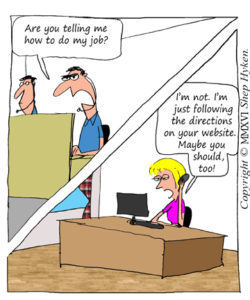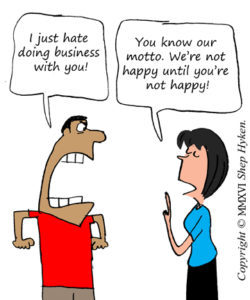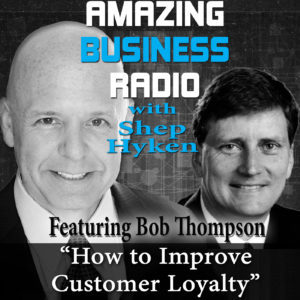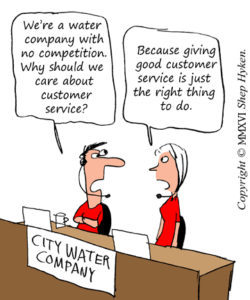Shep Hyken's Blog, page 184
August 16, 2016
Don’t Tell Me How to Do My Job!
 Empathy and Respect
Empathy and RespectHave you ever had a customer tell you how to do your job? While that hasn’t happened to me, I don’t think I would like it. But, what if the customer was right and the employee was wrong? What if the “suggestions” were valid, if not even the right way to get something done?
The other day I was flying home to St. Louis and arrived at the airport very early. I decided to try and get on an earlier flight. I’ve done this many times before. I approached the gate agent and asked to be put on the standby list. He told me the list was closed. I had never heard that excuse before. I have high status on several airlines and one of the perks the airlines offer to their frequent fliers with “status” is to fly standby for earlier flights at no charge. So, I challenged him, ever so nicely. I explained that this was one of the perks of flying a lot on the airline. He responded by asking me, “Are you telling me how to do my job? I’ve been trained and you haven’t.”
That was not what I expected him to say. Rather than get into a confrontation with him, I walked away, went to a different gate agent and made the same request. I mentioned that the agent at the other gate refused to put me on the list, and I didn’t understand why. Neither did this gate agent, so he kindly added me to the standby list.
I walked back over to the departure gate to wait for my name to be called. It turns out that I cleared the standby list and when I walked up to get my new boarding pass, the gate agent that originally wouldn’t put me on the list gave me a strange, if not angry look. I nicely told him one of the other gate agents added me to the list. He was obviously not happy. I just took my boarding pass and smiled as I walked away.
No, I wasn’t telling him how to do his job. But, I will admit to thinking that I probably should have. What I really wanted to say to him when he said, “I’ve been trained and you haven’t,” was… “You are right. You did go through training, but you must have been out the day they taught customer service.” But, I didn’t.
My goal is to be a nice and courteous customer, and sometimes it isn’t easy. We’ve all encountered the employee who is just not friendly or hasn’t been trained properly. It’s frustrating. It can even make you angry. I’ve written about this before. As a customer, we have to be nice. That doesn’t mean we can’t stand firm and speak up for our rights. But, we should do it with tact and courtesy.
Sometimes customers will approach us with suggestions that almost seem like they are telling you what to do or how to do your job. Don’t take offense. They are just trying to get something they think they deserve. Sure, there are unreasonable customers, but that’s a small percentage – hopefully very small percentage – of your good customers. When a customer makes these types of suggestions, listen to him or her with empathy and respect. Then, treat it as an opportunity to deliver an amazing customer experience.
Shep Hyken is a customer service expert, keynote speaker and New York Times bestselling business author. For information contact or www.hyken.com. For information on The Customer Focus™ customer service training programs go to www.thecustomerfocus.com. Follow on Twitter: @Hyken
(Copyright © MMXVI, Shep Hyken)
Save
Save
Save
Save
Save
Save
Save
The post Don’t Tell Me How to Do My Job! appeared first on Shep Hyken.
Amazing Business Radio: Ted Rubin
 Ted Rubin Reveals Tips on How to Build Customer Trust and Get a Return on Relationship (RonR)
Ted Rubin Reveals Tips on How to Build Customer Trust and Get a Return on Relationship (RonR)
Shep Hyken speaks with brand evangelist, social marketing strategist, and keynote speaker, Ted Rubin about branding, customer service, customer experience and, most important, building trust (with both employees and customers). Ted is one of the most influential CMO’s followed on social media and he provides us with great tips and ideas to help strengthen your “Return on Relationships” (#RonR). Business is all about trust, relationships, and the customer experience; so don’t miss this episode of Amazing Business Radio!
Click here to listen and subscribe to Amazing Business Radio on iTunes.
“Relationships are like muscle tissue, the more you engage them, the stronger and more valuable they become.” – Ted Rubin
Save
Save
The post Amazing Business Radio: Ted Rubin appeared first on Shep Hyken.
August 15, 2016
5 Top Customer Service Articles For the Week of August 15, 2016
Each week I read a number of customer service articles from various online resources. Here are my top five picks from last week. I have added my comment about each article and would like to hear what you think too.
Will Chatbots and AI Replace Federal Customer Service Reps? by Phil Goldstein
(FedTech) Advances in messaging and artificial intelligence technology could replace workers in federal call centers.
My Comment: The concept of Artificial Intelligence (AI) and chatbots replacing humans fascinates me. The technology is so much better than it used to be. A good chatbot technology makes recognizing the difference between a human and bot (computer) almost, if not completely, indistinguishable. Will it ever replace human interactions? I don’t think so, at least not completely. There always has to be a “fall back” plan that defaults to human interaction. Interesting read!
4 Tips for Delivering a Richer Customer Experience by Tara Sporrer
(Multichannel Merchant) Here are 4 tips for delivering a richer experience this summer so you can catch online customers in the buying mood before they head off to sunnier pursuits.
My Comment: This short article has four great tips that anyone or any company can use. Simple and common sense, that’s what I like. Call it a “richer” customer experience. It comes from an “easier” experience, which are what these tips seem to be about. And the easier it is to do business with a company, the better chance for repeat business – and maybe even customer loyalty!
6 Must-Dos for Best-In-Class Social Media Customer Service by Sara O’Keefe
(Ignite) If you’ve heard feedback from your customers or fellow marketing experts that your brand could improve, let these must-dos below be your guide to an A grade from your customers.
My Comment: There have been many lists shared about how to be more effective with social customer care. What I like about this list is that several of the ideas aren’t included in the typical list. While the fifth idea on the list, “Make It Private,” might seem anti-social, it really isn’t. Using social media channels to connect one-on-one with customers is a powerful social media customer care strategy.
The 30 Things Customers Really Value by Eric Almquist
(Harvard Business Review) While what constitutes “value” can be nuanced and vary from person to person, my colleagues and I have identified 30 universal building blocks of value that meet fundamental human needs. These are basic attributes of a product or service that address four kinds of needs: function, emotion, life changes, and social impact. Functional elements, for example, include saving time, reducing risk, and organizing. This latter element is central to brands like The Container Store and to Intuit’s TurboTax, because both help consumers deal with complexities in their world.
My Comment: As I read this article and looked at the graphic, I couldn’t help thinking of “Maslow’s Hierarchy of Needs.” Well, this is the “Customer’s Hierarchy of Value.” I find it interesting the pyramid is used to define the most important to the most basic customer needs and values.
How to Make the Move from Reactive to Proactive Customer Service by Silky Sinha
(Business2Community) Do you detect and react to customer problems or wait for the customers to make the first move and ask for help? If you belong to the former category, then you are obviously on the right track as providing proactive customer service is what customers expect today. However, if you fall in the later one, then you are still following the default approach of responding to customers’ problems as they arise. This is reactive customer service.
My Comment: The best companies to do business with seem to not just react to what a customer needs, but also anticipates. That said, being proactive takes it a step further. My favorite example of this (and the simplest way to describe proactive service) is when the server at a restaurant fills the water glass before it is empty and the guest has to ask. How can that way of thinking be brought into the way you do business? Read this article to find out.
Shep Hyken is a customer service expert, professional speaker and New York Times bestselling business author. For information contact or www.hyken.com . For information on The Customer Focus™ customer service training programs go to www.thecustomerfocus.com . Follow on Twitter: @Hyken
Save
Save
Save
Save
The post 5 Top Customer Service Articles For the Week of August 15, 2016 appeared first on Shep Hyken.
August 12, 2016
Guest Blog: What Improvisation Teaches Us About Customer Service
This week on our Friends on Friday guest blog post my colleague, Adam Toporek, writes about how important improvisation is in frontline customer service. It is also important to hire customer service reps that care, and who already have the personality to succeed in a customer service position. – Shep Hyken
For those on the front lines of customer service, perhaps the only constant is variability. Few customer service interactions are exactly the same. At best, reps deal with similar interactions; at worst, they confront a wildly varying landscape of fluid and unpredictable encounters.
To succeed with customers, reps must be able to think on their feet, adapting and improvising with each new customer interaction. Improvisation is a key component of frontline customer service.
Improvisation is also a mechanism for training and improving skills, as our colleagues in the arts know well. Musicians and actors use improvisation to hone skills, to improve reaction times, and to become more adept at adapting to changing circumstances, and in their improvisational explorations, we can find lessons that are applicable to customer service.
Customer Service Patterns and Scripts
Improvisation is at the heart of many musical styles, from rock and roll “jam sessions” to the solos of jazz saxophonist Charlie Parker. Yet, no matter how off the cuff it may sound, great musical improvisation begins with structure and patterns.
Musicians know that to be great at improvisation they first have to learn chord structure and scales. They have to practice patterns or “licks.” And they have to learn to put all of those things together to successfully improvise in real time.
In customer service, we don’t have scales and licks, but we do have language and scripts. The principle is the same.
Many customer service experts are averse to the idea of scripts; however, I believe that customer service scripts are a great starting point for many customer-facing positions, particularly for inexperienced or new-to-the-position reps.
However, scripts should never be a crutch or the complete solution, only a base upon which to build skillful, sincere communication. As Shep says, “You can’t script sincerity.”
The problem with most organizations is they treat scripts like sheet music, something that should be read note for note, instead of as a base of knowledge upon which to improvise authentic dialogue.
Learning key phrases for general customer service and scripts for specific customer service roles can provide a superb foundation for successfully improvising in the moment.
The Power of Yes in Customer Service
Improvisational theater, or improv as it’s called for short, has a rich history in the theatrical community. It is most associated with improvisational comedy, the type made popular by the show Whose Line Is It Anyway and by famous troupes such as The Second City in Chicago.
Like musical improvisation, theatrical improvisation incorporates learned patterns or “bits,” but it also has another convention that is incredibly useful for customer service: “Yes, and…”
One principle of improv is that you are not supposed to say “no” or to negate what your improv partner says. The goal is to accept whatever your improv partner throws at you and work from there. That’s what keeps the scene moving forward.
If your improv partner says, “I just bought a frozen yogurt from the Queen of England.” You shouldn’t say, “That makes no sense.” Instead, you accept the premise and draft off of it.
“You did. Wow, what flavor was it?”
“Royal Raspberry, of course.”
In customer service, “Yes, and…” has a powerful relevance, found in such principles as never telling a customer “no” or pivoting a conversation to what you can do.
Too many reps start off by negating what a customer has said. They want to correct the customer and to defend the organization, themselves, or both. And while there is a place for clarification and correction in customer service, it is rarely the place to start.
Almost every customer interaction is better served by beginning with acceptance instead of rejection. The first helps focus the conversation on what the customer is saying and makes them feel understood; the second focuses on the reps own feelings and makes the customer feel unappreciated.
As customer service consultant John DiJulius often says, “The answer is YES; now what’s the question?”
Of course, there are limits to everything in customer service, but as principles go, you can go along way by accepting what your customer is saying and pivoting your response from there.
Staying in Character while On Stage
Another principle of improv comedy is staying in character. An actor who breaks character during a scene brings the whole sketch to a grinding halt.
Similarly, when we work “on stage” with customers (to use Disney’s classic customer service framework), we are playing a role. Now, “playing a role” does not mean that we are being fake or inauthentic but simply that we are maintaining a professional persona and demeanor.
Often, when frontline reps falter in difficult situations, it is because they break the character of “service professional” and allow their natural reactions to come forward.
The moment this happens; the interaction becomes about the rep instead of the customer.
Remembering to never break character can help anyone working directly with customers depersonalize difficult exchanges and maintain the professionalism that can help successfully resolve even the most challenging of situations.
Improvisation is both art form and training method. By incorporating these three concepts from the world of improvisation, we can better prepare ourselves and our teams for the dynamic world of frontline customer service.
Adam Toporek is an internationally recognized customer service expert, keynote speaker, and workshop leader. He is the author of Be Your Customer’s Hero: Real-World Tips & Techniques for the Service Front Lines (2015), as well as the founder of the popular Customers That Stick® blog.
For more articles from Shep Hyken and his guest contributors go to customerserviceblog.com .
Read Shep’s latest Forbes Article: How To Create A Better Customer Experience
Save
Save
Save
Save
The post Guest Blog: What Improvisation Teaches Us About Customer Service appeared first on Shep Hyken.
August 10, 2016
We’re Not Happy Until You’re Not Happy
 Brand Promise
Brand PromiseEvery once in a while I jokingly will say the motto of a company who gives me bad customer service is:
We’re not happy until you’re not happy.
There are certain industries that this seems to be especially true. People complain and joke about some of their experiences with government agencies. Or, how about the reputation of the cable TV industry? It’s hard to shake off a reputation for bad service that has been going on for years – although they do seem to be getting better. Other industries, such as the airlines and cell phone service providers are doing their best to improve.
First, you have to know that customer’s expectations are higher than ever. They expect good service. We teach the customer what good service is when we tout our awards and make promises. When United makes a promise such as Fly the friendly skies, then they better be prepared to deliver on that promise. That’s why they call it a brand promise! And, when it is delivered, the brand is established.
Unfortunately, businesses can let their customers down. It’s not just happening in the cable TV, airline and phone industries. It’s happening in all industries.
Businesses upset their customer’s numerous ways. Here are just a few:
They make mistakes that cause complaints. No one or no company is perfect. Even the best brands that are known for their customer service, such as Zappos, Nordstrom and others. Customers understand this. It’s the way the problems and complaints are handled that make the difference between the best and the rest.
They make bad hires that aren’t good at delivering customer service. I’m surprised at how some companies allow questionable employees to work in direct customer-facing jobs. Or any job for that matter. One bad employee can lose a customer and bring down a company’s culture.
They have policies that aren’t customer focused. I hate it when an employee says, “That’s our policy.” Typically, that is the line that is used to hide behind rules and policies that are more company-focused than customer-focused. Employees should be given guidelines, not hard-and-fast policies. They should be empowered to come up with creative solutions that are good for the customer, and at the same time, doesn’t hurt the company.
They make it hard to do business with them. I always ask my clients, “How easy is it to do business with you?” It’s important to make the customer experience frictionless. Customers want a hassle-free experience. They want speed and simplicity.
If you’re going to make a brand promise, keep it. Otherwise, you and your company may be the brunt of the punchline… We’re not happy until you’re not happy!
Shep Hyken is a customer service expert, keynote speaker and New York Times bestselling business author. For information contact or www.hyken.com. For information on The Customer Focus™ customer service training programs go to www.thecustomerfocus.com. Follow on Twitter: @Hyken
(Copyright © MMXVI, Shep Hyken)
Save
Save
Save
The post We’re Not Happy Until You’re Not Happy appeared first on Shep Hyken.
August 9, 2016
Amazing Business Radio: Bob Thompson
 Bob Thompson Talks About
Bob Thompson Talks AboutHow to Improve Customer Loyalty
Shep Hyken speaks with Bob Thompson, speaker, author and CEO/founder of the research and publishing firm CustomerThink, about his latest book, “Hooked on Customers: The Five Habits of Legendary Customer-Centric Companies.” Bob also shares some best practices for customer service and what is necessary to ensure a successful customer service strategy. If you want to create more customer loyalty (and who doesn’t), you can’t miss this episode!
Click here to listen and subscribe to Amazing Business Radio on iTunes.
“You have to hire the right talent to begin with, but then you have to equip them, empower them, and train them.” – Bob Thompson
Save
The post Amazing Business Radio: Bob Thompson appeared first on Shep Hyken.
August 8, 2016
5 Top Customer Service Articles For the Week of August 8, 2016
Each week I read a number of customer service articles from various online resources. Here are my top five picks from last week. I have added my comment about each article and would like to hear what you think too.
Five Questions Customer Experience Professionals Are Asking Today by Michael Hinshaw
(McorpCX) Everyone is talking about customer experience. What it is, why it’s important, how to deliver and how to improve it. Everyone, it seems, has an opinion. Which is why I thought you’d be interested in hearing what the experts are wondering about.
My Comment: This short article has five simple, yet powerful questions related to a company’s customer experience strategy. Reading the questions won’t take but just a few minutes. But answering them is another story. However, if you take the time to do so, I’m sure you’ll come up with some insights to help raise the level of your CX.
The Star Wars Guide to Net Promote Score by Paul Campillo
(TypeForm) Customers may not betray you like Anakin, but when your best customer decides to leave your business for good, wouldn’t it be nice if they told you why?
My Comment: If you are a Star Wars fan, you will love this article. (And even if you’re not.) The author uses Star Wars examples and artwork throughout the article to teach concepts and strategies related to NPS (Net Promoter Score). There’s some great information here, and it’s a blast to read. May the NPS Force be with you!
Nobody Knows if Voice Is Growing or Shrinking by Shai Berger
(Fonolo) Are voice interactions becoming a smaller part of the customer service picture? That’s a pretty important question for everyone involved in the call center industry.
My Comment: Is phone support the best way to get customer service and support? Are self-service options or technologies like instant chat overtaking what has been the most popular way to connect with a company? This article by Shai Berger, CEO of Fonolo and an expert in the customer support world, shares his thoughts in this thought provoking article.
7 Steps to a Flawless Loyalty Program by Timi Garai
(Antavo) Well, after helping our customers build their loyalty programs, we’ve found the next 7 important steps to create a flawless loyalty program and put them into an infographic! Plus, the infographic also explains how a loyalty program can help to increase your ecommerce store’s profit.
My Comment: This short article is actually an infographic with great information about creating a loyalty program. Timi shares some creative “how-to’s” as well as a few interesting stats and facts to support the various concepts shared. And, the layout of the infographic makes it fun to read.
What Exactly Is The Future of Customer Service? by Dan Gingiss
(PureMatter) There’s a lot of talk about customer service these days, with social media driving much of the conversation: Customer service is the “new marketing”. It’s a major driver of a great (or lousy) customer experience. Millennials are demanding more of it, but on their terms. It’s vastly underfunded when compared with marketing spend.
My Comment: If you looked in a crystal ball to predict the future of customer service, what would you see? Well, you don’t need a crystal ball. You just need to read this excellent article by Dan Gingiss. And, once you read the article, be sure to download and listen to some of the episode on his Focus on Customer Service podcast.
Shep Hyken is a customer service expert, professional speaker and New York Times bestselling business author. For information contact or www.hyken.com . For information on The Customer Focus™ customer service training programs go to www.thecustomerfocus.com . Follow on Twitter: @Hyken
The post 5 Top Customer Service Articles For the Week of August 8, 2016 appeared first on Shep Hyken.
August 4, 2016
Guest Blog: Left Brain, Right Brain: Aligning Internal Culture and Customer Analytics
This week on our Friends on Friday guest blog post my colleague, Jeff Dahms, write about the importance of using customer data properly and aligning it with the internal culture of an organization. Data is worthless unless you have the right data and then do something with it. – Shep Hyken
Data inspires confidence because it serves as a rational, objective bottom line that provides order and structure to the customer experience. It appeals to the logical, pattern-oriented left brain, involved in making decisions that shape the customer experience. But customer analytics have more to tell you than scores alone. By reading between the lines, the shape of your company’s internal culture can emerge.
WHY IS INTERNAL CULTURE RELEVANT?
Think of data as representing the ongoing feedback loop between a company’s internal culture and its customers. This loop runs smoothly when the culture is well aligned with the customers’ needs, wants, and expectations. A productive, motivated, well-informed staff produces satisfied customers, and vice versa.
If the culture is misaligned, though – if priorities are skewed, if there is distrust between leadership and employees, if there are significant obstacles to cooperation across departments, if employees don’t feel valued and morale is low – the impact on customer service is direct and immediate. Inefficient processes, gaps in information and communication, and employees who are just ‘going through the motions’ are all symptoms of an unhealthy internal culture that needs attention.
Customers tend not to tolerate these symptoms for long. Remember, a single negative interaction with your business can sour a customer’s opinion and undo a long history of positive interactions in a matter of minutes. Studies have shown that negative experiences have more staying power than positive ones; not only are people more likely to remember them, they are more likely to tell others about them, too. Social media has given customers a megaphone for complaints that they might otherwise just have grumbled about under their breath.
IF DATA REPRESENTS THE LEFT BRAIN, CULTURE REPRESENTS THE RIGHT BRAIN.
Together, these elements form the foundation of customer experience management.
Customer analytics, used appropriately, can be the healing salve for a broken internal culture. By examining the trends, gaps, and other insights captured within the data, all employees, from upper management down to the individual customer service representatives, get a clear sense of the goals they are working toward as a team and what they can do to affect positive change.
This requires a degree of transparency between those who have access to the data and who make decisions, and those who carry out those decisions in their daily interactions with customers. A stern top-down directive given without context or reason is easily ignored or deprioritized, while one that is presented as a productive initiative backed by solid information is more motivating and harder to argue with.
Of course, transparency must go both ways if the staff is to work as a team. Employees at all levels of the company should feel empowered to ask questions, make suggestions, or otherwise participate in the shaping of the culture, and not just be beholden to policies. By valuing the voice of your employees, especially those who are in the position to directly interact with customers, you create an internal culture that nourishes the customer experience – and the data is bound to reflect that.
As a right-brain, intuitive element of the customer experience, cultural alignment can be felt as much as observed. Take this opportunity to do a “gut check” about the culture in your office and within the enterprise as a whole. Do you notice any symptoms? Have they emerged recently, or have they persisted, unattended, for some time? If anything, no matter how small, feels off in some way, don’t ignore your gut.
Of course, gut feelings are subjective and not always the best source of insights for developing an action plan. Whether your internal culture is noticeably skewed or it’s simply time for a routine check-up, collecting employee engagement measurements starts you off on the path of improvements. Much like Voice of the Customer surveys, employee assessments help identify the key drivers that motivate employees to bring their best effort to work.
The culture is in the numbers: where the right and left brain connect.
Jeff Dahms is Vice President of Research & Development at Customer Service Profiles. Jeff has over 12 years of experience managing and consulting to data for both internal and external clients, and has extensive experience in helping Executives focus on key indicators in order to achieve maximum results. At CSP, Jeff is responsible for executing all phases of the customer service measurement process, including designing surveys, analyzing data, identifying trends, and helping clients implement changes.
For more articles from Shep Hyken and his guest contributors go to customerserviceblog.com .
Read Shep’s latest Forbes Article: The State Of The Customer Experience 2016
Save
Save
The post Guest Blog: Left Brain, Right Brain: Aligning Internal Culture and Customer Analytics appeared first on Shep Hyken.
August 3, 2016
4 Tips for Ensuring Your Customers Are Treated Better
 Use Common Sense
Use Common SenseMy sister, Kim, lives in Park City, Utah. She moved from one home to another about two years ago. Four months later her water was turned off, and she found a notice on her door that she was in arrears with her payments to the water company. She knew there was a mistake. She was set up to “auto-pay” the water bill with her credit card, the same as she had done for her previous home.
She immediately called the water company and talked with Brenda Wilde, the Water Billing Coordinator. Brenda listened to Kim’s “story” and upon doing a little research found out that while Kim had filled out the paperwork correctly, it wasn’t properly notarized. While one could argue that it was my sister’s fault, Brenda’s focus was on taking care of her customer and immediately activated the auto-pay, waived penalties and interest owed as well as the fees for disconnection and emergency reactivation.
Great ending to a customer service story, but it doesn’t end there.
Fast forward about 18 months. Once again, Kim sold her house and purchased another. This time she filled out the paperwork properly and auto-pay worked. But, for some reason she was still paying the bills on her old house as well. Once Kim discovered she was being double-billed, she called Brenda who immediately fixed the problem and credited her account. Brenda also mentioned that she remembered Kim from the last incident.
Just a few months later, Kim was out of the country and received a call from her “friend” Brenda who was inquiring about a big “spike” in water usage. Kim explained that she’d been out of the country for several weeks and no one was home using the water. Brenda offered to look into it further and called her back 30 minutes later to inform her that she was using – actually losing – water at about 600 gallons an hour. There was a major leak in a pipe at her home.
Brenda immediately dispatched an emergency team to shut the water off at her home. Thanks to Brenda, a bigger disaster, such as a major flood in the basement, was averted. There was still some water damage, but it could have been much worse. When Kim finally came back from her trip she stopped by the Water Company to personally thank Brenda and drop off a small gift of appreciation.
Several lessons here:
Make it personal – My sister, Kim, was positively overwhelmed by the service she received from her local utility company. Her explanation was that Brenda made her feel like she was dealing with a person, not a big company.
Use common sense – In the first billing situation, where Kim had her water shut off, Brenda realized that Kim was an honest customer. She had never missed payment in the past. It was obvious there was a mistake. She waived all fees and set up an emergency call to restore the water service. Many companies would let policy and process interfere with common sense. Not Brenda. It was obvious there was a mistake with the second house. Common sense says, “Take care of the customer.”
Remember your customers – Brenda recognized Kim’s name when she called back a second – and third time. Was it really Brenda’s amazing memory? Or was it a good CRM software program? It doesn’t really matter.
It’s just the right thing to do – Finally, the water company is a public utility. It’s a monopoly. In other words, there isn’t any competition. Yet, Brenda saw her way to providing a stellar customer experience. Why? Because it’s just the right thing to do!
Shep Hyken is a customer service expert, keynote speaker and New York Times bestselling business author. For information contact or www.hyken.com. For information on The Customer Focus™ customer service training programs go to www.thecustomerfocus.com. Follow on Twitter: @Hyken
(Copyright © MMXVI, Shep Hyken)
Save
The post 4 Tips for Ensuring Your Customers Are Treated Better appeared first on Shep Hyken.
August 2, 2016
Amazing Business Radio: Bruce Turkel
 Bruce Turkel Shows Us How to Brand for
Bruce Turkel Shows Us How to Brand forCustomer Service Success
Shep speaks with branding expert, author, and professional speaker Bruce Turkel about how to brand your company for customer service. Bruce shares important tips and tools from his new book, “All About Them,” as they discuss the influence your customers have on your brand and how properly branding your company is essential for success. Listen to this episode of Amazing Business Radio and learn how to build your brand and reputation with your customers. The book may be titled, “All About Them,” but this episode is all about you!
Click here to listen and subscribe to Amazing Business Radio on iTunes.
“You can’t be all things to all people, pick a lane.” – Bruce Turkel
Save
The post Amazing Business Radio: Bruce Turkel appeared first on Shep Hyken.



